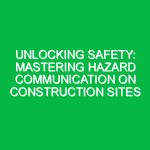Demolition work is inherently dangerous. It involves a variety of high-risk activities, including working at heights, operating heavy machinery, and handling hazardous materials. For Health Safety and Environment (HSE) professionals, ensuring the safety of workers during demolition projects is paramount. This article outlines ten essential demolition safety tips that every HSE professional should know to mitigate risks and protect workers.
Understanding the Importance of Demolition Safety
Before diving into the specific safety tips, it’s crucial to understand why demolition safety is so important. Demolition sites are unpredictable. Structures can collapse unexpectedly, hazardous materials can be released, and accidents can happen in the blink of an eye. By implementing rigorous safety protocols, HSE professionals can significantly reduce the risk of injuries and fatalities on demolition sites.
1. Comprehensive Planning and Risk Assessment
Every demolition project should start with thorough planning and a detailed risk assessment. Identify potential hazards, such as structural weaknesses, the presence of asbestos, or proximity to power lines. Develop a plan that addresses these risks, including emergency response procedures. This step is critical in anticipating and mitigating potential dangers before work begins.
2. Ensuring Proper Use of Personal Protective Equipment (PPE)
PPE is the last line of defense against injuries on a demolition site. Ensure that all workers are equipped with the necessary PPE, including hard hats, safety glasses, gloves, and steel-toed boots. For specific tasks, additional protection like respirators or hearing protection may be required. Regularly inspect PPE for damage and replace it as needed.
3. Training and Competency
Workers should be adequately trained on the specific hazards associated with demolition work. This includes training on the correct use of tools and machinery, understanding of the site’s safety plan, and awareness of emergency procedures. Competency is key; only workers who have demonstrated the necessary skills and knowledge should be allowed on site.
4. Safe Use of Machinery and Equipment
Heavy machinery, such as excavators and bulldozers, are often used in demolition. It’s essential that operators are fully trained and certified to use these machines. Regular maintenance and inspections should be conducted to ensure that all equipment is in good working order. Establish exclusion zones around machinery to protect bystanders and other workers.
5. Hazardous Materials Management
Demolition sites can contain hazardous materials like asbestos, lead, or chemical residues. Proper identification, handling, and disposal of these materials are crucial. Workers dealing with hazardous materials should receive specialized training and use appropriate PPE to minimize exposure.
6. Dust Control Measures
Dust generated during demolition can pose significant health risks, including respiratory problems. Implement dust control measures such as water spraying, dust extraction systems, or enclosing the work area. These steps can help to reduce airborne particles and protect workers’ health.
7. Noise Control and Hearing Protection
Demolition sites are often noisy environments, which can lead to hearing damage over time. Use noise control measures such as sound barriers or quieter equipment where possible. Ensure that workers have access to and use hearing protection when necessary.
8. Managing Work at Heights
Working at heights is common in demolition and poses a significant risk of falls. Use guardrails, safety nets, or personal fall arrest systems to protect workers. Training on safe work practices for heights is also essential.
9. Effective Communication and Signage
Clear communication is vital on a demolition site. Use signs, signals, and two-way radios to convey important safety information. Establish a clear chain of command and ensure that all workers know who to report to in case of an emergency.
10. Emergency Preparedness and Response
Despite all precautions, emergencies can still occur. Have a comprehensive emergency response plan in place, including evacuation routes, assembly points, and access to first aid. Regularly conduct drills to ensure that all workers know how to respond in an emergency.
Summary of Key Points
Ensuring safety on demolition sites requires careful planning, training, and vigilance. By following these ten essential tips, HSE professionals can create a safer work environment:
- Conduct comprehensive planning and risk assessments.
- Ensure proper use of Personal Protective Equipment (PPE).
- Provide adequate training and ensure worker competency.
- Ensure safe use of machinery and equipment.
- Manage hazardous materials properly.
- Implement dust control measures.
- Use noise control and hearing protection.
- Manage work at heights safely.
- Ensure effective communication and signage.
- Be prepared for emergencies with a solid response plan.
By prioritizing these safety tips, HSE professionals can help to protect workers from the many hazards associated with demolition work. Remember, a safe demolition site is no accident; it’s the result of careful planning and diligent safety practices.


